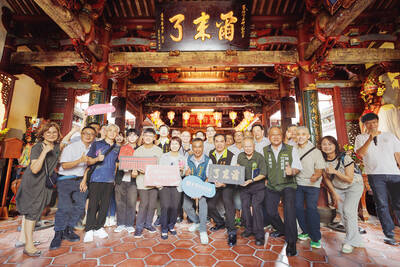With a rapidly aging population and a cash-strapped National Health Insurance system, the government is paying more attention to the issue of “futile medical care,” treatment applied only to prolong life without a foreseeable cure or positive outcome, and the prospect of hospice care.
In a seminar held by medical groups yesterday, National Taiwan University Hospital (NTUH) Jinshan Branch Superintendent Huang Sheng-Jean (黃勝堅) made a presentation on how the community hospital he directs in Jinshan established the first hospice community in Taiwan.
Huang was assigned to the post by NTUH less than two years ago, when the hospital planned to initiate a pilot program promoting local, close-to-home healthcare and hospice community care in the district.
“Physicians at Jinshan branch don’t just stay in the hospital. They visit patients and their families at home and participate in community health-promotion activities to relate to local people,” Huang said.
The hospital is now employing the capitation payment system, which can be seen as a family practice system, Huang said, with a physician taking care of a number of patients closely instead of being visited by patients randomly.
The system works under the idea that pain prevention is more important than treatment, Huang added, stressing that this kind of preventive healthcare includes reducing the patient’s and their family’s suffering at the end of their life.
“Of the NT$570 billion [US$18.9 billion] healthcare expenditure paid by the NHI, about NT$170 billion is spent on futile medical treatment,” Huang said. “By operating preventive healthcare, including building quality end-of-life care and promoting the signing of DNR [do not resuscitate] to have ‘a good death,’ a lot can be saved, benefiting the sustainability of the NHI system.”
“The rate of the patients under end-of-life care that had signed the DNR was 9.2 per 1,000 last year, compared with a national rate of 6.3 per 1,000,” Huang said, adding that the number is expected to exceed 10 per 1,000 this year.

The Central Weather Administration (CWA) today issued a "tsunami watch" alert after a magnitude 8.7 earthquake struck off the Kamchatka Peninsula in northeastern Russia earlier in the morning. The quake struck off the east coast of the Kamchatka Peninsula at 7:25am (Taiwan time) at a depth of about 19km, the CWA said, citing figures from the Pacific Tsunami Warning Center. The CWA's Seismological Center said preliminary assessments indicate that a tsunami could reach Taiwan's coastal areas by 1:18pm today. The CWA urged residents along the coast to stay alert and take necessary precautions as waves as high as 1m could hit the southeastern

FINAL COUNTDOWN: About 50,000 attended a pro-recall rally yesterday, while the KMT and the TPP plan to rally against the recall votes today Democracy activists, together with arts and education representatives, yesterday organized a motorcade, while thousands gathered on Ketagalan Boulevard in Taipei in the evening in support of tomorrow’s recall votes. Recall votes for 24 Chinese Nationalist Party (KMT) lawmakers and suspended Hsinchu City mayor Ann Kao (高虹安) are to be held tomorrow, while recall votes for seven other KMT lawmakers are scheduled for Aug. 23. The afternoon motorcade was led by the Spring Breeze Culture and Arts Foundation, the Tyzen Hsiao Foundation and the Friends of Lee Teng-hui Association, and was joined by delegates from the Taiwan Statebuilding Party and the Taiwan Solidarity

Instead of threatening tariffs on Taiwan-made chips, the US should try to reinforce cooperation with Taiwan on semiconductor development to take on challenges from the People’s Republic of China (PRC), a Taiwanese think tank said. The administration of US President Donald Trump has threatened to impose across-the-board import duties of 32 percent on Taiwan-made goods and levy a separate tariff on semiconductors, which Taiwan is hoping to avoid. The Research Institute for Democracy, Society, and Emerging Technology (DSET), a National Science and Technology Council think tank, said that US efforts should focus on containing China’s semiconductor rise rather than impairing Taiwan. “Without

The National Museum of Taiwan Literature is next month to hold an exhibition in Osaka, Japan, showcasing the rich and unique history of Taiwanese folklore and literature. The exhibition, which is to run from Aug. 10 to Aug. 20 at the city’s Central Public Hall, is part of the “We Taiwan” at Expo 2025 series, highlighting Taiwan’s cultural ties with the international community, National Museum of Taiwan Literature director Chen Ying-fang (陳瑩芳) said. Folklore and literature, among Taiwan’s richest cultural heritages, naturally deserve a central place in the global dialogue, Chen said. Taiwan’s folklore would be immediately apparent at the entrance of the